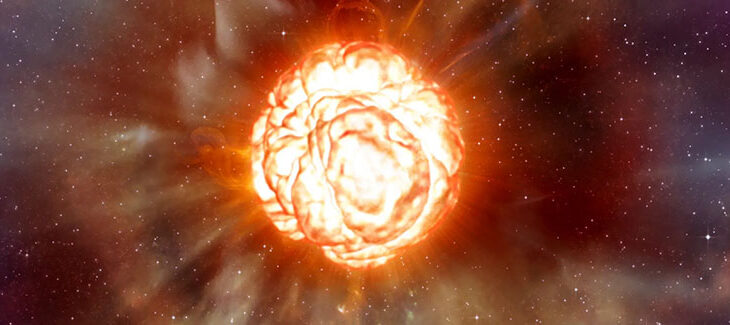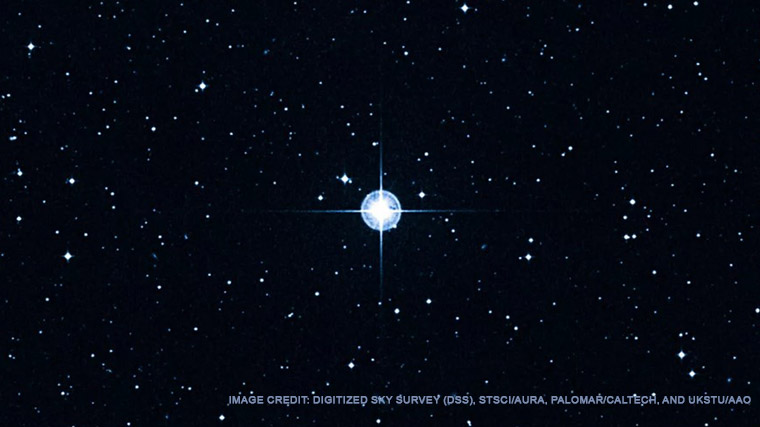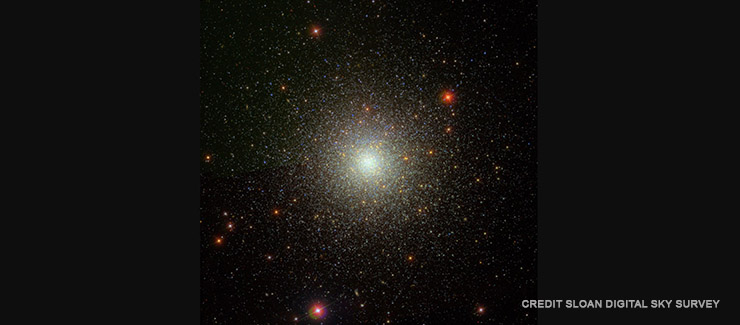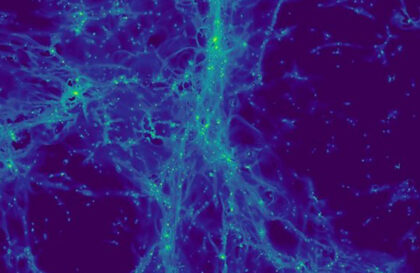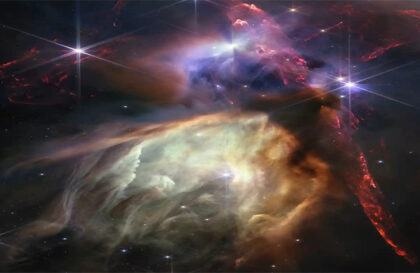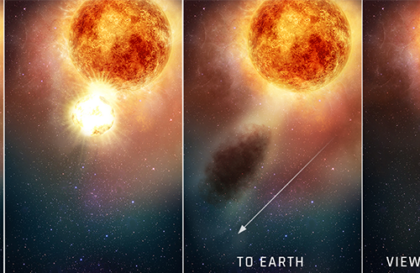Betelgeuse is an aging red supergiant located in the constellation Orion. It has a mass of about 5 to 6 solar masses, a luminosity of 100,000 times that of the Sun, and a temperature of about 3200 C / 5800 F. The star is a variable Cepheid that exhibits slow, irregular changes in brightness and size with a period of variability of 0.2300 days and magnitude from 0.624 to 0.33.
Its diameter is estimated to be about 850 miles / 1367.98 km, it is less dense than air, and its color has changed from yellow-orange to red over the past few thousand years. Also, Betelgeuse would extend past Jupiter, and if placed in the center of the solar system, it would swallow up all the rocky planets. Its atmosphere consists of a photosphere, MOLsphere, gas shell, chromosphere, dust medium, and two outer shells (S1 and S2) consisting of CO.
The star is here compared to the size of the Solar System. Credit: ALMA (ESO/NAOJ/NRAO)/E. O’Gorman/P. Kervella
Betelgeuse emits only 13% of its radiant energy as visible light, and its J-band magnitude is -2.99, indicating its “redness” with a B-V color index of 1.85. Betelgeuse is predicted to explode as a supernova due to its extreme luminosity and is estimated to be 8-10 billion years old. Betelgeuse has a high fraction of 13C compared to 12C and evolved from an O-type main sequence star.
How does Betelgeuse’s size compare to other stars in the night sky?
Betelgeuse is one of the giant stars, about 700 times the size of the Sun and 15 times more massive. Betelgeuse is visible to the naked eye and is more extensive than Rigel-Beta Orion, considered the brightest star in the constellation. At times, Betelgeuse rivals Vega and Capella in brightness, while at other times, it is fainter than Deneb and Mimosa.
Credit: NASA
Although Betelgeuse is one of the largest stars visible to the naked eye, it is not the largest star. Stephenson 2-18 and UY Scuti are the current size record holders with estimated radii of 2150 and 1708 solar radii, respectively. In addition, Mu Cephei, VV Cephei A, and VY Canis Majoris have larger estimated radii than Betelgeuse. But Betelgeuse is the brightest star in the night sky and ranks among the largest stars ever discovered by astronomers.
What is the temperature and luminosity of Betelgeuse?
View of the surface of Betelgeuse as captured by the Hubble Space Telescope (1995). Credit : A. Dupree (CfA), R. Gilliland (STScI), FOC, HST, NASA
Betelgeuse has a relatively cold surface temperature of about 3,600 Kelvin, much lower than the Sun’s surface temperature of about 6,000 Kelvin. This means that Betelgeuse is cooler than the Sun, making it one of the coldest stars in the universe. Betelgeuse’s effective temperatures range from 3250 to 3690 Kelvin, with an uncertainty range of -3575 to +3625, and much of this variation is believed to be natural due to atmospheric pulsations. While a star’s size determines temperature, its luminosity does not, and Betelgeuse’s exact luminosity is challenging to decide on due to uncertainties in its size, distance, and surface temperature. However, a 2012 research paper estimates the luminosity to be around 126,000 L☉, assuming a distance of 200 parsecs. This makes Betelgeuse much brighter than Rigel – Beta Orion, the brightest star in the constellation.
Where is Betelgeuse in the night sky?
Betelgeuse is easy to see with the naked eye all over the globe except Antarctica at latitudes south of 82°. The best time to observe Betelgeuse is from mid-September to mid-March, and the best sightings are in mid-December. If you look at the constellation Orion in the night sky, Betelgeuse is on the Hunter’s left shoulder. Betelgeuse marks the center of the Winter Hexagon and is one of the three stars that make up the Winter Triangle asterism, along with Rigel and Sirius.
Find Betelgeuse in the sky with the free stargazing app Star Walk 2 for iOS and Android.
It is located at a distance of about 650 light-years from Earth. Betelgeuse is known to periodically dim and brighten in brightness, which affects its ranking in the night sky. It is also close to several known deep-sky objects and lies between Procyon in Canis Minor and the nearby constellation of the Unicorn.
Supernova Betelgeuse will be visible even during the day on Earth and will be the brightest object in the sky for several weeks or months.
The Betelgeuse supernova will throw massive material into space, forming new elements and dust clouds. These elements and materials can become building blocks for future stars and planets.
Betelgeuse is located about 640 light-years from Earth, so its supernova will not directly threaten our planet. However, the large amount of energy emitted by a supernova can affect the Earth’s ionosphere, causing changes in the operation of radio communication and GPS systems.
In 2019, the star tore off a significant portion of its surface.
Banner image: ESO/L. Calçada
Image credit:
https://starwalk.medium.com
https://vaonis.com
https://vaonis.com
